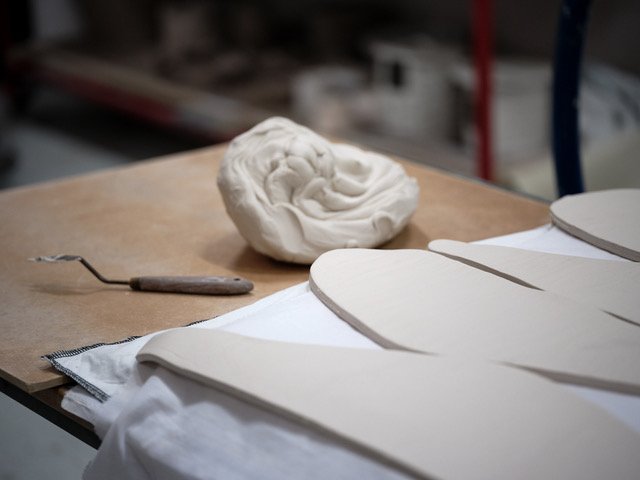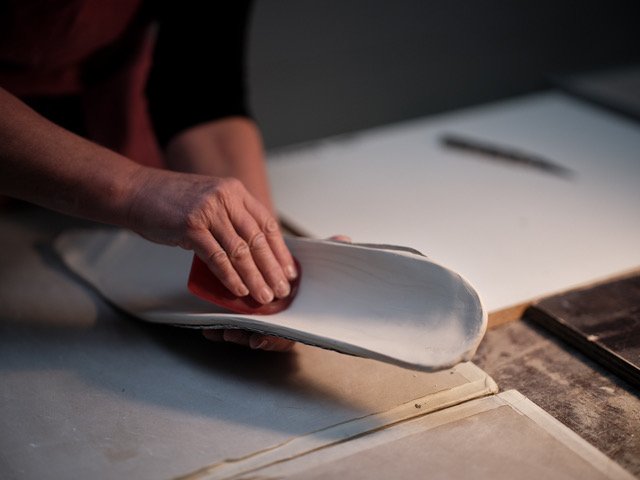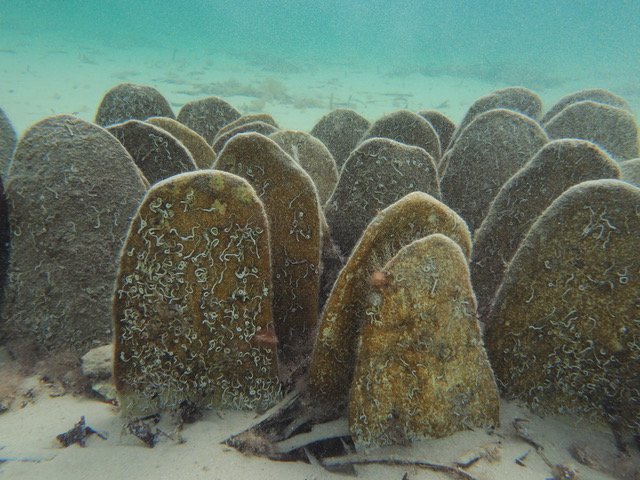This project has been assisted by the Australian Government through the Australia Council for the Arts, its arts funding and advisory body.
Jane Bamford
Ceramic Razor Fish forms as Collectors for Native Oyster (Ostrea angasi) spat on Oyster Reef Rehabilitation Project - Kangaroo Island 2021 -2023
Learn about this project here https://www.youtube.com/watch?v=gerL1C2i6kU or read on…
In 2021 Jane was approached by Paul Jennings of the Kangaroo Island Landscape Board (KILB) to explore the possibility of creating ceramic forms as a substrate, or a place to grow native flat oysters (Ostrea angasi). This opportunity would form a small part of a larger project to restore a series of small angasi reefs and habitat they provide.
Before European settlement, native flat oysters were widespread and abundant across southern Australia, forming extensive reefs above and below the tideline. Over-harvesting decimated the species to the point where now, only the odd patch of angasi oysters exists on mainland Australia, including on Kangaroo Island (KI). It is estimated that 85% of native shellfish reefs have been lost globally, with over 90% of angasi reefs lost across Australia.
As part of this project, Jane worked closely with Paul Jennings and Alex Comino, project manager from the KILB, to design these ceramic forms, modelled on pinna, or razorfish as commonly known.
Razorfish are an important structural element found in coastal waters around KI. Their large structure provide habitat for a myriad of marine life, including angasi oysters. This relationship is extremely important on KI and around South Australia as there are so few suitable habitats left where native oysters are found. The relationship between razorfish and angasi has been well known since oyster fishing began in Southern Australia. Oyster larvae are attracted to substrates rich in calcium, like their own shells, which helps them aggregate and combine with other shellfish to form large reefs.
Jane’s handmade ceramic forms are created from different clay bodies, resulting in different textures and chemical compositions. Trialling these different clays may identify a preferred substrate mineral composition for KI’s native oysters. Clay is an ideal material, being of the earth, non-polluting, negatively buoyant and bio-secure once fired. About one third of the form is buried into the substrate and held in place by liquefaction, much like you may have experienced when you dig your feet into wet sand.
In 2021 Jane created 100 ceramic razorfish forms which were deployed into marine environment to give early information on design suitability and oyster settlement data.
In 2022 Jane created another 1000 razorfish forms which have now been deployed by KILB divers into the reefs restoration sites alongside other substrates being trialled. Jane’s work has been assisted by the Australia Council for the Arts. Jane is also grateful for an artist in residency with the University of Tasmania’s Centre for the Arts and Media for 5 months to create this large run of work. This runs alongside funding from the Australian Government’s Fisheries Habitat Restoration Program and contributes to a national initiative to restore shellfish reefs.
This astonishing collaborative project has been documented by the KILB team and in 2023 through the videography of marine biologist and filmmaker, Stefan Andrews/Ocean Imaging. https://www.theocean.com.au/ Stefan works on projects that focus on communicating scientific research, animal behaviour, marine ecology, and conservation. In addition, KILB will use a monitoring and evaluation approach in accordance with the Australian Government’s Natural Resource Management Monitoring, Evaluation, Reporting and Improvement Framework.
Jane’s collaborative work with KILB delivers a high quality, art/design and science-based initiative to the community in response to an environmental need which is incredibly applicable to the current epoch of marine reef degradation and species decline.
Jane’s creative rationale is a vision that artists can collaborate with scientists and use their knowledge of material to create work with scientific research. This brings their work and scientific research to a different audience. This intention is a significant key step for engaging collaboration but also creates an alternative career pathway for creative practitioners.
‘I see artistic design and development of habitat support as innovative and important creative work. I believe artists, working closely with scientists, are uniquely placed to translate scientific knowledge into possible practical solutions.’ Jane 2021
For more information on the KI Landscape Board’s oyster reef restoration please visit their website here: https://www.landscape.sa.gov.au/ki/native-plants-and-animals/oyster-reef-restoration
Text: Jane Bamford and Alexandra Comino 2023









